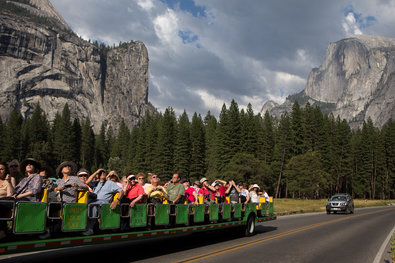
Should Overcrowded National Parks Have Restricted Access?
It’s the 100th anniversary of the National Park Service this year, and record crowds are expected at many of the most popular sites this Memorial Day weekend. But the throngs of tourists are straining the parks the agency protects, increasing pollution and creating conflicts between humans and wildlife. Should the Park Service more widely restrict access to protected areas, or does that contradict its mission to keep the lands open and accessible?
* overcrowded = 너무 붐비는, 초만원인/ anniversay = 기념일/ Memorial Day = (미국의) 전몰장병 추모일(5월 마지막 월요일로 공휴일); 현충일/ throng = 인파, 군중/ strain = 한계에 이르게 하다, 무리를 주다/ wildlife = 야생 동물/ restrict = 제한[한정]하다/ contradict = 부정[부인]하다, 반박하다, 모순되다/ accessible = 접근[입장/이용] 가능한; 이해하기 쉬운
 공원 관리청은 보호 지역으로의 입장을 더 광범위하게 제한해야 하나요, 아니면 이것은 공원 관리청의 국토를
공원 관리청은 보호 지역으로의 입장을 더 광범위하게 제한해야 하나요, 아니면 이것은 공원 관리청의 국토를
개방하고 접근 가능하게 하는 임무에 모순이 되나요?
1. Charge for Attendance at the Most Popular Parks
This would alleviate crowding and generate much-needed funds for maintenance. After all, preservation is not free.
2. Limiting Access to Parks Is Rarely Necessary
There are other steps that can be taken to mitigate the impact of crowds on both the environment and visitor experience.
3. An Issue that Doesn’t Resonate With Many African-Americans
Many of the most popular parks that are threatened are not the ones African-Americans frequently visit.
4. Attract Americans to Lesser-Visited Parks
Educational partnerships could engender appreciation among new park goers, who may be more drawn in by history or wildlife than just to the most popular spots.
Sample Essay
Limiting Access to National Parks Is Rarely Necessary
As park stewards, we must protect our natural resources, to leave them unimpaired for future generations. And of course, nobody likes overcrowded parks. But there are steps that can mitigate the impact of crowds on both the environment and to visitor experience without closing or restricting access to parklands.
Even when I was superintendent of the Blue Ridge Parkway, the most visited national park unit in the United States, it rarely became so crowded that visitors couldn't enjoy it, or that resources were damaged. This has remained the case even as visitation topped 15 million people last year.
Crowding was a more significant challenge at Yosemite, where I was the park's administrative officer. To accommodate more people and lessen the environmental impact, we did eliminate many of the social trails. But we also built boardwalks to lessen damage to the valley floor and restored stream banks and other riparian zones that were degraded by heavy visitor use. Shuttles helped transport visitors around the valley without car pollution.
In an even more extreme case, in the Outer Banks, the distress of the endangered piping plover led park officials to limit visitation and restrict car access to certain sections of the beach during times of the year and days when protected shorebirds and turtles were nesting.
But these sorts of restrictions are usually unnecessary.
The biggest impediment to park health is the lack of funding for day-to-day operations and an adequate number of trained employees. The most popular national parks continue to work with nonprofit partners, who donate both time and money to support the parks. Strong federal appropriations would help a lot. Only a fraction of 1 percent of the federal budget goes toward protecting the parks — a grave underestimation, considering the wild popularity of these places.





![]() 공원 관리청은 보호 지역으로의 입장을 더 광범위하게 제한해야 하나요, 아니면 이것은 공원 관리청의 국토를
공원 관리청은 보호 지역으로의 입장을 더 광범위하게 제한해야 하나요, 아니면 이것은 공원 관리청의 국토를






